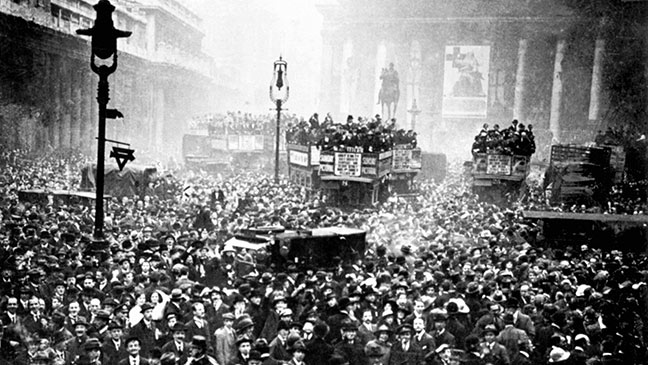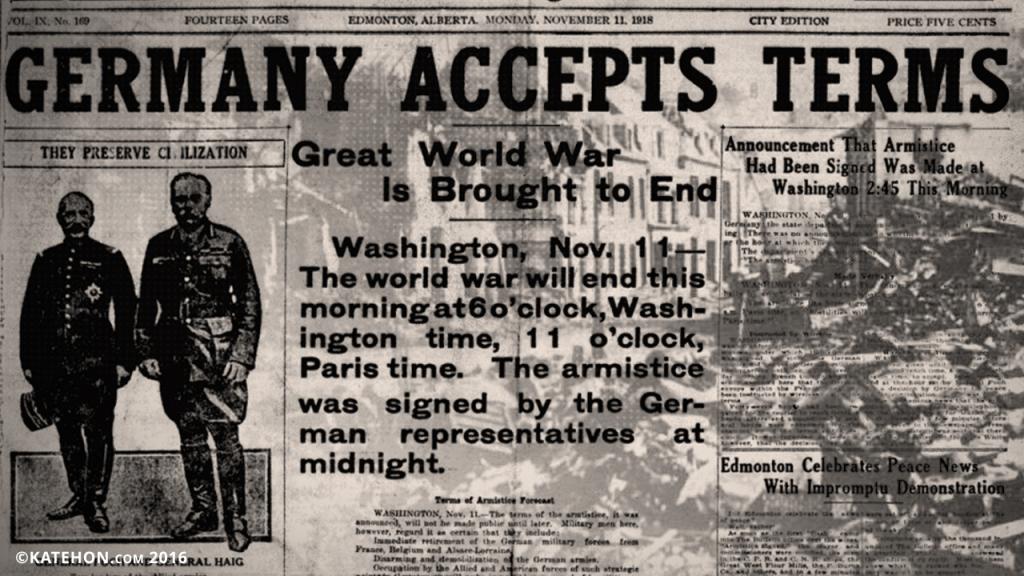The Guns Grow Silent
Special to The Great War Project
(11 November) They call it an armistice, but in reality it is a German surrender.
So writes historian Adam Hochschild. “It was a most unprecedented one, however, for the surrendering army despite being severely bloodied, remained well-armed, several million strong, and almost entirely on the territory of its enemies.”
“But with a near-starving Germany in turmoil behind it, and rear area troops deserting, it could not fight on, even though only a few months earlier, almost at the gates of Paris, it had seemed poised to win the war.”
Hochschild goes on:…
“Triumphal German government propaganda had continued until the last minute. Newsreels never showed troops retreating or surrendering – leaving many civilians thinking that whatever their sufferings, the country’s soldiers were on the verge of victory.”
Reports Hochschild, Marshal Foch lays down the armistice’s terms on behalf of the Allies. He is representing a country that had suffered a staggering toll: 1,390,000 men killed.

Americans celebrate the peace, November 11th.
“The Marshal,” according to historian Hochschild, “demanded that the German army withdraw from France, Belgium, and the provinces of Alsace and Lorraine that had been captured from France years earlier.”
Also, the Allies demand that the Germans withdraw from territory in Russia. and from territories in Germany itself. “Germany was also to pay the cost of stationing Allied troops there and more.”
There would be far more detailed and onerous demands of Germany to come.
The armistice is signed in Foch’s railway car in the forest of Compiegne at 5 a,m. November 11th 1918, to go into effect six hours later. “Senselessly to no military or political purpose, Allied infantry and artillery attacks continued full steam through the morning.”
“On this final half day of the war, after the peace was signed, 2738 men from both sides were killed, and more than 8000 were wounded.” Throughout the morning of the 11th American commanders order their men to continue the fight until 11a.m.

London peace celebration
Writes historian Martin Gilbert: “The men who died or were maimed in those last few hours suffered needlessly,” writes another historian. At one French village, a Canadian soldier, George Price, “was awaiting, as were millions of his fellow soldiers, the ending of the war.”
“It was two minutes to eleven. At that moment a German sniper bullet rang out, and Price was killed, one of the very last casualties on the Western Front.”
At two minutes to eleven, Gilbert reports, “a German machine gunner with his watch out after firing off a belt without pause, was seen to stand up beside his weapon, take off his helmet, and then walk slowly to the rear.”

Fantastic series on the War to End all Wars, which of course, it wasn’t. I thoroughly have enjoyed your articles.
First rate job Mike Shuster. And I’m not prejudiced because Mike is my second cousin.
I AM prejudiced because Mike is my friend. This has been an amazing scholarly, detailed, heart-breaking account of a hideous, agonizing conflict. Thank you Mike for your dedication and persistence. Please go on and tell us of the initial aftermath — conditions in France,Germany, America, Russia. What was the first post-war world like in the first year of peace? What were the challenges for those returning,their families and friends?
The WWI Cenetennial Commission had a post on 11/10/18 honoring Fr. Duffy, the most decorated cleric. Since a portion of today’s GWP post is about the senseless deaths on 11/11/18, I add the following:
Let’s not forget Father William Davitt. He was killed in France on November 11, 1918 at 9:45AM – 75 minutes before the armistice. Born in Holyoke, MA and raised across the Connecticut River in the city of Chicopee. Davitt had been a priest in western Massachusetts before enlisting. He was awarded the Croix de Guerre and the Distinguished Cross for leading a rescue party in the summer of 1918, helping to save the lives of 40 soldiers. He was buried in France, during the 1920s, his remains were returned to the US and he is now rests in Calvary Cemetery in Holyoke. I’ve been told he was the last American serviceman killed in WWI.
Mike, I add my sincere thanks and appreciation for your steadfast dedication to this commemorative project over the last years. Truly an awe-inspiring task you have done for us.
Is this chapter “The End”? Or are you going to continue until the June 1919 Treaty of Versailles? (And let’s be honest, the centennial lead-in to WWII pretty much starts there as well).
This has been a monumental undertaking thank you for doing this and for all of your efforts to tell this history in real time, wonderfully done.
Mike: I join our colleague Susan Stamberg in acknowledging a bias in your favor. This has been an outstanding series of pieces of journalism…first-rate reporting of events that still mark our lives. And even though we know how it ends, the stories of how it got there remain thrilling in your telling. Congratulations on fine work. – Alex
Mike, this has been a magnificent effort on your part to keep alive not only the memories of just how awful the Great War was but also the lessons that we should have learned from it but, sadly, still seem eager to ignore.
The fighting in that war might have stopped on November 11, 1918, but the fight for sanity in public affairs continues.